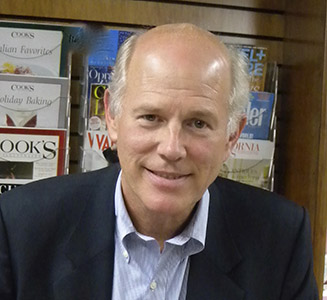Prior to the completed construction of the Bay and Golden Gate Bridges, ferry commuters could gaze upward to track the course of a Pan Am Clipper takeoff bound for Pago Pago, Macao, or some other exotic destination during the golden age of flight.

Author Barnaby Conrad III.
By Paul Duclos
Published: May, 2014
Prior to the completed construction of the Bay and Golden Gate Bridges, ferry commuters could gaze upward to track the course of a Pan Am Clipper takeoff bound for Pago Pago, Macao, or some other exotic destination during the golden age of flight.
Ed Musick was the first brave soul to have flown across the Pacific Ocean in 1935, and soon many others were to follow. All this and more is contained in a captivating new book, Pan Am: An Aviation Legend, authored by Barnaby Conrad III.
Recently reissued by San Francisco publisher Council Oak Books, this handsomely-illustrated account of Pan Am chronicles the airline’s first commercial flight from Key West to Havana in 1927. This was the year airline visionary and company founder Juan Trippe teamed up with heroic aviator Charles Lindbergh to pioneer routes into the Caribbean and South America. Enlisting early aircraft builders Sikorsky, Martin and Boeing, Pan Am developed planes that finally conquered the vast Pacific and Atlantic oceans, breaking down the boundaries that separated peoples and cultures.
During its first 40 years, the company was responsible for virtually every innovation in commercial aviation, from safety and performance features in its aircraft to jet travel at affordable fares. Along the way, Pan Am attracted endorsements from celebrities, the mistrust of Presidents and the envy of competitors. Pan Am: An Aviation Legend recounts the great friendship between Trippe and Lindberg, and the secret wartime mission Franklin Roosevelt made aboard a Pan Am Clipper.
With its logo on everything from tiny single-engine planes to the magnificent 747, Pan-American changed the way Americans saw the world and the way the world viewed America. Although Pan American World Airways ceased flying in 1991, its photographic history stirs the imagination of the air traveler just as images of the Orient Express, the Titanic and the Concorde intrigue railroad, ocean-liner and aviation buffs.
With more than 250 illustrations and vivid text, the book honors not only Pan American’s golden era of the 30s and 40s, but also depicts its iconic style of the 50s and 60s jet age in an unforgettable manner. "Someday," wrote Claire Booth Luce in 1941, "a clipper flight will be remembered as the most romantic voyage in history."
Cultural Currents has long been a fan of Barnaby Conrad III, who has written on many of the artifacts and traditions that define mannered manhood: martinis, cigars and blondes, among others. (Check out Chronicle Books archives for these books and more.)
At a recent book-signing party staged by the fine arts gallery Modernism, Conrad was also talking about his impressive monograph Mark Stock: Paintings. Stock died suddenly this spring, and Modernism will be honoring him with a memorial exhibition this month.
Mark Stock’s paintings connect viewers to the euphoria, loneliness and sometimes fatal entanglements of romance. Often melodramatic and tinged with irony, Stock’s images illustrate love’s power to provoke our best, and most illicit, behavior. A well-dressed voyeur peeks past the curtain of a mansion window, silent and intent on the object of his desire. Picnicking lovers look into each other’s eyes. An attractive woman smokes a cigarette as she sits next to a man’s corpse, which has been rolled neatly in a carpet, ready for disposal. Stock’s paintings tell the story of each character with remarkable subtlety and, in many cases, with humor. Stock is, after all, a master of the realist style, and he uses color, shadow and line to amazing effect. Details in facial expression, body language and background tell you there’s more going on here than rapture, scandal and dangerous liaisons. These paintings keep you coming back for another look, for clues to life’s telling moments.
Perhaps best known for The Butler’s in Love – Absinthe, Stock created a body of work long championed by Modernism and collectors like Doug Biederbeck, the founding proprietor of legendary watering hole BIX on Gold Alley, and the Ferry Building’s Marketbar.
Biederbeck is an author too, having written Bixology: Cocktails, Culture and a Guide to the Good Life. Here’s a cocktail recipe from this enchanting, vest-sized handbook:
La Feuill Morte
The color of this traditional French drink is meant to resemble that its namesake, a dead leaf.
One and one-half ounces pastis
Three-quarters ounce grenadine
Three-quarters ounce mint syrup
Combine ingredients in a rocks glass with ice. Serve with ice water on the side.
Paul Duclos is the author of Flags of Convenience. Signed copies are on sale at the Bay Crossings store located in the center of the Historic San Francisco Ferry Building.

Painter Mark Stock will be honored with a memorial exhibition this month.

